Autumn is full of work for summer residents, in addition to harvesting, planting flower beds and other winter plants. It is a mistake to think that this is an easy process that does not require knowledge and skills. With improper planting, growth slows down and even their death is possible. Planting onion flowers is an important process for proper growth and healthy plants. It is important to know how and when to plant the corn kernels, for this it is easier to use step-by-step instructions.
Content
- 1 Advantages of Autumn Flower Planting
- 2 What bulbs can be planted in the fall
- 3 When to plant bulbs of flowering plants
- 4 Place and soil selection
- 5 Bulb pruning
- 6 Digging and drying bulbs
- 7 In what months should bulbs be planted
- 8 Overview of florist preferences and the most popular varieties
- 9 When to buy Bulbs
- 10 Conclusion
Advantages of Autumn Flower Planting
You can plant plants in spring, but planting bulbous flowers in autumn provides more benefits:
- Gardeners plant flower bulbs after they harvest and clean the garden. These processes are not done in a hurry, but alternately, measuredly. In the spring there is no such opportunity, because, in addition to planting flowers, they prepare the soil and grow seedlings.
- Planting material is sold at a discount at fall. In spring, prices are much higher.
- In the fall, stratification occurs in vivo, no need to additionally create an imitation of winter colds.
- It is convenient for plants to tolerate planting in the cold. With the onset of frost, the pests disappear, but the soil remains warm for some time. This helps the plant to take root and develop roots before the ground freezes deep.
- Planted in the autumn months, bulbous flowers sprout earlier than others in spring. They bloom too faster.
- In the fall, heavy rainfall occurs, the soil becomes well moistened and the plants are already in favorable conditions. Due to this, gardeners save themselves from the need for additional watering.
What bulbs can be planted in the fall
At the end of the garden season, flower growers share shrubs and plant bulb flowers in the winter. These include:
- lily;
- crocus;
- Adonis;
- echinacea;
- astilbe;
- peony;
- tulip;
- lupine;
- hyacinth;
- stonecrop;
- aconite;
- evening primrose;
- rudbeckia.
If the deadlines for planting bulbs are met, then the flowering of annuals is more plentiful and longer. This is due to the natural process of stratification.
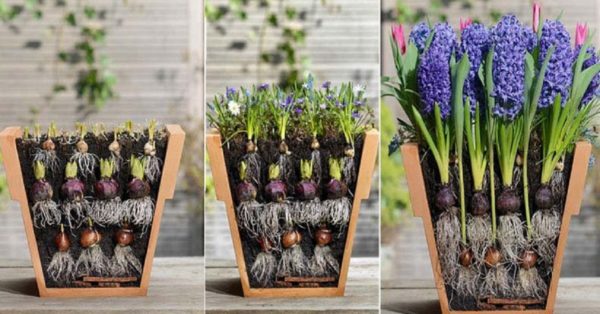
When to plant bulbs of flowering plants
For proper development and dense flowering, the corms need cool calm after planting. Therefore, gardeners, starting in mid-August and ending in the second half of September, plant autumn bulbous flowers:
- Crocuses
- hazel grouse;
- daffodils;
- phlox;
- astilbe;
- Muscari
- chionodoxes;
- rudbeckia.
By the end of September, tulips and lilies are planted. Poor planting material is not recommended to be purchased, it will not sprout. It is better to spend more money to buy good material in places that are considered reliable. If the cornea is collected on its site, then they make the rejection of the sick and small, leaving the largest and the whole.
Place and soil selection
Bulbous plants are planted under trees, because they will bloom before the leaves on the branches bloom. In rockeries and rock gardens perfectly fit the Scylls, crocuses, bluebells.
Bulbous flowers for active growth and abundant flowering need a soil filled with nutrients in which excess fluid does not linger. If the earth is clay, sand is added to it. Dense, heavy soil must be brought to a normal balance. Before planting, the ground is fertilized and watered.
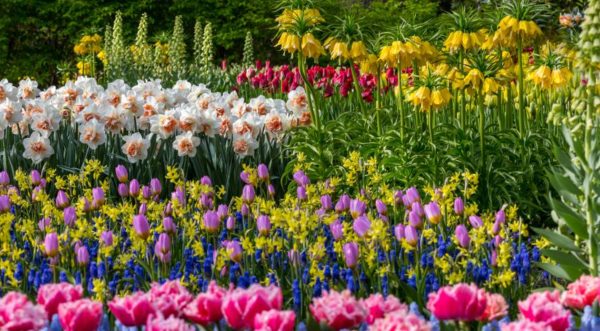
Landing Features
Before the autumn planting of bulbous flowers, the tubers are carefully inspected. If they find damaged, they are treated with potassium permanganate, and the bruised places are greased with brilliant green. These events contribute to better flowering of future plants. Bulbs that are slightly rotten should not be planted. They infect the remaining rhizomes, as a result, all plants become ill immediately after planting.
The soil
In the fall, the bulbs strengthen their root system to make it easier to survive the winter and bloom profusely in the spring. For this, the soil is prepared and nourished. Preparatory activities begin a few months before landing. Compost is added to adjust the acidity of the earth. Bulbs like neutral soils or with low acidity. Add substances that retain moisture and loosen the soil.
Cornels are not recommended to be planted at the same place. Bacteria and pathogens remain in the ground. Even fungicide-treated roots run the risk of infection and death. Therefore, to preserve the bulbs, they are planted annually in a new place.
Bulb Planting Technology
Depending on what kind of plants gardeners plant, the depth of planting varies. But there is a rule suitable for bulbous flowers that are planted in autumn - the depth should be at least three sizes of the tuber. If the diameter is 2 cm, then a layer of earth 6 cm is poured on top.
A suitable place for planting bulbs is a lawn. The turf layer is removed, and planting material is placed in the ground. Top cover with the same turf.
Some types of soil become denser from a lot of rain. In such cases, sand or another light substrate is added to the onion well. This should be done so that the depth of the pit remains the same. In dry autumn, the bulbs after planting are abundantly watered and mulched. As mulch, fallen leaves, sawdust or peat are used.
A gap of about 15 cm is left between adjacent bulbs. For large roots, a large planting depth is required. It is achieved by covering with a high mulching layer.
Flowers that are too susceptible to cold and moisture quickly decay. Therefore, freshly planted plants are covered with a greenhouse film on top. But in the spring it is removed on time, otherwise the bulbs vanish and die.
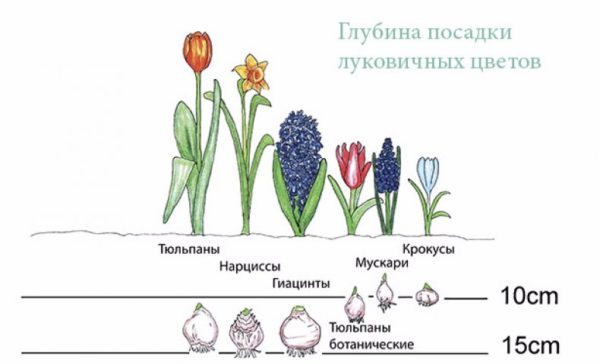
Bulb pruning
Bulbs also need pruning. This stage begins after a flowering period. Therefore, you need to know the features of the correct haircut:
- after the plants fade, cut the ovaries. This is done so that the flower does not spend energy on the formation of seeds;
- the stems are left because they help to accumulate nutrients;
- in faded plants, leaves cannot be cut off or tied so that they dry faster;
- bulbs are removed only after the leaves have completely dried.
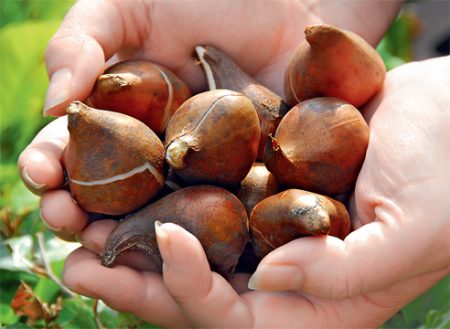 You may be interested in:
You may be interested in:Digging and drying bulbs
Dig, dry onion should be as follows:
- the bulbs are gently dug up, the earth is shaken from them, additional roots are removed, and then dried in a shaded, well-ventilated room;
- bulbs of crocus, pushkinia, and stamen are stored in the same room until planting;
- crocus, muscari, snowdrop, white flower, kandyk are not dug up every year, they grow in one place for 6-7 years.
In what months should bulbs be planted
Depending on the type of plant, the timing of its winter landing varies:
- September. At the beginning of the month, gardeners are engaged in dividing bushes, replanting plants such as solidago, phlox, astilbe. Gardeners plant small-bulb flowers: Scylla, Pushkinia, crocuses, Muscari. Closer to the middle of the month, daffodils are planted, and after 5-7 days - hyacinths. The date for planting tulips is the last week of September. It is important to follow the correct deadlines, because if everything is mixed up, then the plants will not develop a strong root system.
- October. Planting tulips and hyacinths can be delayed until mid-October, if winters come later in your climatic conditions. Places planting hyacinths cover with a film so that the soil does not gain more moisture during the autumn rains. "October" tulips are easier to fight viruses. Cold and damp soil is perfect for bulbs of these colors.
- November. If autumn turned out to be warm, the temperature did not fall below +3 ° C, then tulips are planted in November. But you need to be careful with this, because if the temperature conditions are not observed, the flowers slow down their growth or even die.
If bulbs for tulips are acquired late, then they are planted at home in a special container, it will be safer for planting material and the plant will not freeze. Proper care in this case is very important, because you need to do everything so that they bloom on time. In the spring, a fairly strong grown plant is planted in open ground.
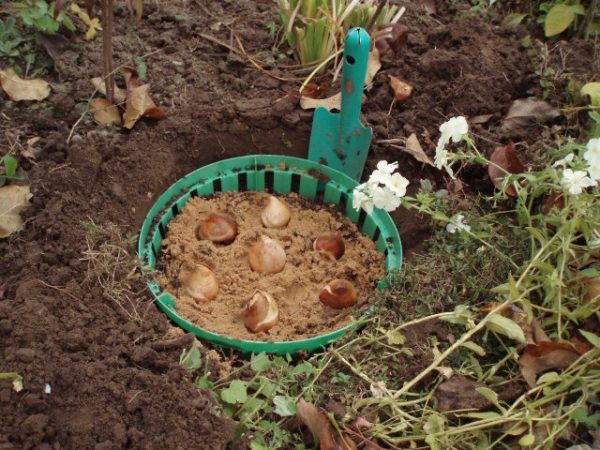
Overview of florist preferences and the most popular varieties
Different varieties of onion need a certain type of soil, the amount of sunlight and moisture. Depth of landing is also different. Conditions for the most popular varieties:
- Muscari. Loose, drained soil is suitable for these flowers. Muscari love sunny places, so they are not planted in the shade. Bulbs are buried to a depth of 8 cm with a gap between plants of 10 cm.
- Crocuses These flowers love permeable ground and sunlight. They are planted in the same way as muscari.
- Daffodils. Plants bloom well both in the sun and in the shade. Leaky soil is suitable for them. Landing dates - August-October.
- Tulips These flowers are the most unpretentious among bulbs. They do not need special conditions, but their diversity is amazing. Varieties differ from each other not only in color, but also in shape. They are distinguished by the longest period of autumn planting and the possibility of home distillation.
- Lilies The soil for planting lilies is fertilized and drained. Different varieties require their own conditions for planting.
- Fritillaria, fritillaria. Sunlight and drained soil are important to these colors. They are planted with an interval equal to two sizes of bulbs. Orange plants are visually very similar to lilies.
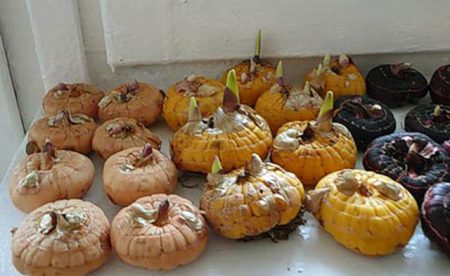 You may be interested in:
You may be interested in:When to buy Bulbs
The best option is to purchase plant bulbs shortly before the planting process. But this does not always work, because the bulbs of summer plants are sold only in winter. That is, they must be properly stored until disembarkation. Planting stock purchased ahead of time is placed in peat or sand and stored indoors at a temperature of about 5-7 ° C.
Conclusion
Bulbous plants bloom very beautifully and are pleasing to the eye. To achieve such a good result, gardeners spend a lot of time, put a lot of effort into the correct planting and the care necessary for the flowers. Different varieties require their own soil preparation rules; they need to be known. But the invested efforts will not be wasted.Bulb plants are striking in their amazing flowering and great diversity.

 10 beautiful annuals that bloom all summer
10 beautiful annuals that bloom all summer Sow in the ground, without seedlings: 10 beautiful and unpretentious flowers
Sow in the ground, without seedlings: 10 beautiful and unpretentious flowers Platicodon planting and outdoor care
Platicodon planting and outdoor care Hosta - planting and care in the open ground in the Urals
Hosta - planting and care in the open ground in the Urals